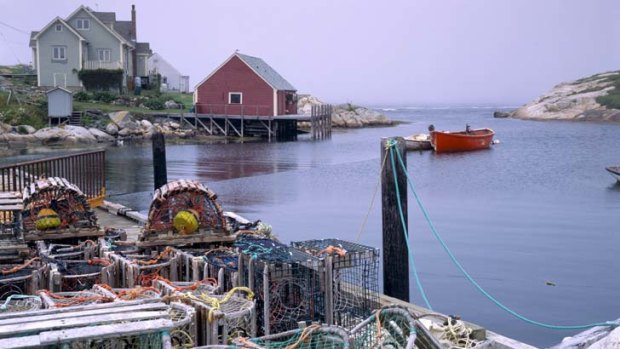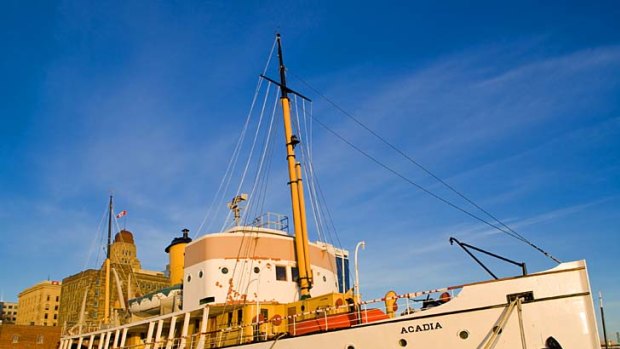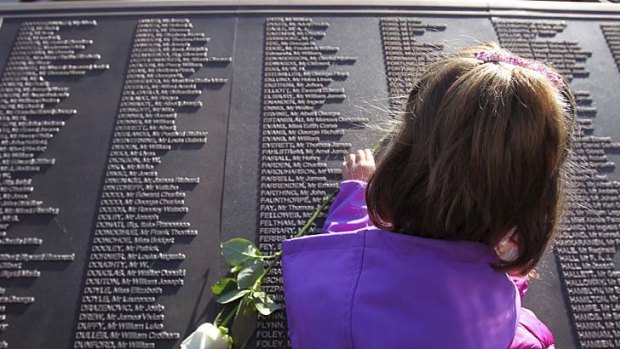This was published 11 years ago
Ghost harbour
Shadowed by two of history's worst maritime tragedies, Halifax still celebrates the sea, writes Amy Cooper.

Chilling history ... Halifax Harbour.Credit: Getty Images
On the Halifax waterfront stands a statue of Sir Samuel Cunard, founder of the famous shipping line. His silhouette represents this Canadian harbour city's greatest pride - and its most tragic irony.
Halifax, Nova Scotia, is the birthplace of Cunard, a pioneer of modern trans-Atlantic sea travel. But this harbour, where he launched the first steam-driven ancestors of today's ocean liners, has since witnessed two of history's worst maritime disasters.
Cunard lived before either occurred. Today, his bronze gaze across the harbour is sombre, as if he can see its ghosts.
One hundred years ago from this spot, he could have watched the cable ship Mackay-Bennett sail slowly into Halifax with its main mast flag at half-staff, bearing 190 recovered bodies from HMS Titanic. The "death ship" was the first - and most heavily loaded - of four recovery vessels charged with the grim task of collecting the Titanic dead after it struck an iceberg and sank 700 nautical miles off the Canadian coast on April 15, 1912.
While the 700 survivors of the stricken liner were transported to New York, Halifax was the consolation of the unlucky. They never bought a ticket to this small port on the eastern coast, but all 209 recovered bodies from the 1522 dead came here and 150 remain.
Halifax is playing its part in the worldwide Titanic centenary circus; musicals, a re-enacted funeral parade and church services headline commemorations that will be held throughout the year.
While the sea has delivered disaster, it sustains this city.
From the moment Halifax was designated the centre for recovery operations in 1912, it was destined to be linked to the Titanic forever. Previously known only for maritime success and invention, its people - known as Haligonians - had to adapt to the mantle of tragedy suddenly thrust upon them.
They have done so with dignity. From the first curious onlookers to the historians, scientists and treasure hunters passing through to an influx of Leo fans titillated by Hollywood myth, Halifax has welcomed its disaster tourists as respectfully as it once did the grieving relatives who flooded in searching for lost loved ones in April and May 1912.
While other "Titanic cities", such as Belfast, the ship's birthplace, have embraced the world's obsession with the ship, Halifax has gently resisted being defined by Titanic.

CSS Arcadia outside the Maritime Museum of the Atlantic, Halifax.Credit: Alamy
When you arrive by sea, as I do, you step straight into the city's happier history. Pier 21 at the Cruise Pavilion is Canada's only remaining immigration shed and houses the impressive Canadian Museum of Immigration. A million optimistic newcomers have entered the country through here.
Next door in Pier 22, numerous stalls of tartan, handicrafts and celtic charms pay twee testament to the Haligonians' Scottish and Irish heritage. The pedlars are defiantly perky, as if trying to bury the ship-shaped elephant in the room beneath a barrage of harmless tat. It works, too. It would seem mean-spirited to raise the Titanic, as it were, among twinkly-eyed ladies plying hand-knitted bears and speciality teas.
The first glimpse of Titanic is just along the boardwalk, in the Maritime Museum of the Atlantic. Here, a permanent exhibit tells the story through Halifax's eyes with a selection of poignant artefacts. There's a poster advertising Titanic's voyage from New York on April 20, 1912, which it never made. The museum also documents the city's greater maritime history and the dawn of the age of steam, conceived here by Cunard.

A plaque commemorates the victims of the Titanic.Credit: AFP
Here, too, you'll discover the other great sorrow haunting Halifax's seafaring past.
The Titanic disaster turned out to be a dress rehearsal for tragedy on an even greater scale just five years later. On December 6, 1917, two ships collided in the harbour, creating the most devastating man-made explosion the world had seen before the nuclear age. The Halifax Explosion killed more than 1900 people, injured 9000, wrecked more than 13,000 homes and businesses and left 6000 people homeless. The city was instantly reduced to ruins.
At the time, Halifax Harbour was filled with ships servicing the European war effort. One of these was the French SS Mont-Blanc, laden with more than 2500 kilograms of unstable explosives. When it clashed with the Belgian relief ship SS Imo, two square kilometres of civilisation were obliterated immediately, the Mont-Blanc's hull shot 300 metres into the air, debris scattered for more than five kilometres, and the harbour bottom was briefly sucked into view before an 18-metre tsunami smashed the Imo into the harbour's opposite shore. The human carnage was unspeakable. Even today, the explosion remains a global benchmark of destruction.
We're told the story by a city tour guide. Joe is a typically chirpy Haligonian, peppering the tale with jovial asides. He describes the last, desperate manoeuvre of the Mont-Blanc as a "dipsy doo-da zigzag". Eyebrows are raised. One guest mutters that he finds the relentless jolliness of the locals odd, considering how much misery their city has endured. But you can't blame the Haligonians for refusing to let tragedy be their trademark. While visitors might wallow in the past, those who live here have had to make their peace with it. So they'll tell you about Halifax's positive associations with the sea, its great shipbuilding tradition and distinguished military record. They point you to the vibrant, developing waterfront. They know that while the sea has delivered disaster, it sustains this city.
Our next destination is Fairview Lawn Cemetery, resting place of 121 Titanic victims and site of a mass grave for the Halifax Explosion's unidentified dead. A simple sign points to the four rows of Titanic graves aligned in the curve of a ship's bow. Each bears a number by which the passengers were identified. Most have names. All are inscribed with the same date: April 15, 1912.
It is a serene place. But Hollywood hype has reached here. One grave belongs to a J. Dawson and since the 1997 movie it has been strewn with flowers from female fans of the Leonardo DiCaprio character Jack Dawson. The real inhabitant is a humble coal trimmer named Joseph.
There's the affecting monument to "an unknown child", now identified through DNA as 19-month-old Sidney Goodwin, a third-class passenger. His grave also represents the 53 children lost in the disaster.
The largest stone belongs to the only Australian victim recovered, Arthur McCrae. The Sydney engineer was travelling second class on the way to Canada to visit friends. His is one of a few bigger headstones paid for by families. But the rest are identical and standard issue.
The graves speak more eloquently of the tragedy than any movie could. While the Titanic legend has swollen to fantastical proportions during a century, these uniform rows of unassuming stones are the most tangible connection to its truth. You're struck by the ordinariness of them and of the lives they represent, so at odds with the overblown romance of the Titanic tale. No matter how epic the tragedy or how many times it is told, the real ending is here, and it is stark, small and final. We leave Halifax that night. Our own giant ship glides out slowly through the harbour and past the proud Sir Samuel.
A little further along the harbour is another symbol of maritime pride. The CSS Acadia, a beautiful Edwardian steamship, now rests permanently at the Maritime Museum. It was built the year after Titanic's demise and is the only ship still afloat to have survived the Halifax Explosion. It worked out of this harbour for 56 years and was so loved by its crew that they still care for it today.
Acadia is a celebrity, too - it's starred in seven movies. It is resilient, like its home port, and I strongly suspect that it is for this ship, not the other more famous, doomed one, that Halifax would prefer to be remembered.
Trip notes
Cruising there
Holland America Line offers numerous Canada/New England cruises with ports of call in Halifax. hollandamerica.com or Travel the World, 1300 804 522, traveltheworld.com.au.
Flying there
Qantas, Air Canada and United Airlines fly to Halifax with two stopovers. Prices start from about $2500.
The writer travelled on Eurodam, courtesy of Holland America.
Sign up for the Traveller Deals newsletter
Get exclusive travel deals delivered straight to your inbox. Sign up now.